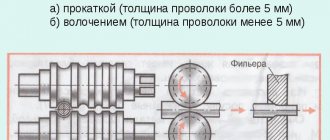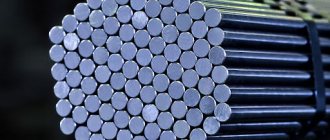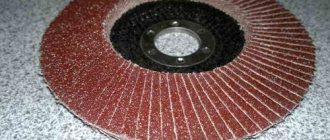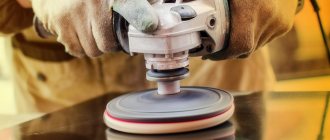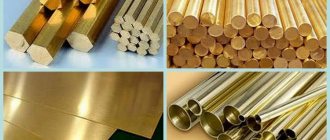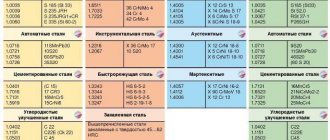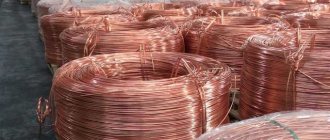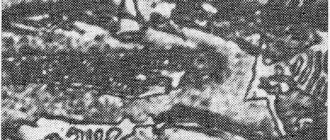Steel reinforcement A1, wire rod and circle are very similar, but different metal products. All of them can be sold in bundles or in rods, but they differ in properties, manufacturing features and areas of use. All these differences are reflected in the cost of rolled metal.
It is worth understanding that it is not worthwhile to arbitrarily change the wire rod, reinforcement and circle to each other. After all, this will affect the quality of work and make costs ineffective. In the article we will find out the main differences and areas of use of the listed metal products.
Circle
The hot-rolled wheel can have high, increased or normal manufacturing accuracy. Product characteristics are regulated by GOST 2590-2006.
The range of diameters of metal products is 5–250 millimeters. With values from 5 to 14 mm, rolled products are supplied in bundles. Diameter 10–250 mm is produced only in rods. For the production of the circle, steel grades can be used: St.5, St.20, St.0, St.25, St.45, St.08, 09G2S, 30KhGSA, 15Kh, 40Kh, 10KHSND, U8, St.35 and U8A. Circles longer than 6 meters can only be based on high-alloy steel.
Heat treatment
To increase the strength of the wheel, additional heat treatment is allowed at the request of the client.
Usage
Production of wire, nails and springs. Hot-rolled wheels are also used for making gratings, frames, turning bolts, bushings, and reinforcing reinforced concrete structures. Can be used for the production of fences of various configurations.
Properties
Combination of elasticity with high strength.
The appearance of the circle does little to justify its name
Why should you choose a steel circle?
The steel circle is easy to transport, as it is packed tightly into bags and secured with a minimal amount of wire. Such a package can weigh from several kilograms to several tons. Transportation is carried out both by road and rail.
There is a wide range of steels that are suitable for the production of round metal:
- Stainless and tool steels 12ХН3А, 20ХН3А, 40ХН2МА, 38Х2МУА, 38ХС, 60С2А, 60С2ХFA, 4Х5МФС;
- Structural steels: steel St20, steel 35, steel 45, ШХ15, Р6М5;
- Low alloy steels: steel St3, 09G2S;
- Alloy steels: 18KhGT, 25KhGT, 30KhGSA.
When used, a fairly maximum amount of waste comes out, especially if we consider the production of parts on turret machines. The workpiece is ideally matched in diameter to the diameter of the part, and when shortening the workpiece, a minimum allowance is required.
Equally important is that the waste from the steel wheel used in the manufacture of parts does not contain harmful impurities.
The steel circle is resistant to corrosion and temperature changes, has a wide range of applications, high strength and relatively low cost. That is why the steel circle is so in demand in the rolled metal market.
Steel circle and its classification
The generally accepted designation used in documentation and catalogs is “circular steel rolled metal” .
The steel circle is distinguished by its manufacturing method:
- Hot rolled steel circle;
- Cold rolled steel circle;
- A circle produced by forging.
The surface of the steel circle is often processed - polished. Each type of steel circle has a number of advantages. Cold rolled is more accurate in diameter and is suitable for making galvanized steel circle.
If the diameter of the circle is up to 9 mm, it is supplied in skeins; if it is larger than 9 mm, it is supplied in rods.
For circular rolled metal, the diameter of which is more than 9 mm, based on the purpose of the circle, the length is:
- Measured;
- Unmeasured;
- Multiple measured.
Steel circles of measured and multiple measured lengths are made from steel:
- Length 2-6 m - made of alloy and high-quality carbon;
- Length 2-12 m - from low-alloy and carbon of ordinary quality;
- Length 1-6 m - made of high-alloy steel.
There are three GOST standards for the cross-sectional diameter of a steel circle:
- Normal accuracy - maximum permissible deviations range from −4 mm to +0.8 mm, marked “B”;
- Increased accuracy - maximum permissible deviations range from −2 mm to +0.6 mm, marked “B”;
- High accuracy - maximum permissible deviations in diameter range from −0.9 mm to +0.3 mm, marked “A”.
Wire rod
The production of steel rods is regulated by GOST 30136-95, in the international classification ISO 8457/1-89. According to this document, the allowed diameter of products is from 5 to 11 millimeters. Carbon steel grades St.0 and St.1 are used for production, the quality is normal.
During production, a hot billet (bloom) is rolled through rollers that compress it from all sides. The result is wire, which, after shaping, is wound into rings. Then natural cooling of the product occurs. After this, the skein is tightened using metal bands. If the wire rod is used to make wire, the formation of burrs on its surface is unacceptable. In other cases, minor defects are not so critical.
Heat treatment
During production, steel wire rods are cooled naturally using air. One- and two-stage accelerated cooling is also used - УО1 and УО2. It is carried out at the request of the client. For this purpose, fan installations are used.
Usage
Wire rods are used in the automotive industry, the production of aircraft, machine tools and ships, for reinforcing reinforced concrete structures, as well as for the production of pipes and long products. It can be used for the production of metal ropes, telegraph poles, and electrodes.
Properties
Softness relative to reinforcement and circle. Thanks to this, the wire rod can be given various shapes.
This is how reliable frames are made using wire rod
Steel circle and its application
This type of rolled metal is widely used both in mechanical engineering and in the manufacture of metal structures, etc.
The main industry for using steel circles is construction. They are used to make fences, column reinforcements and metal structures, and they are also used for reinforcement.
In industries, they are used for mechanical engineering or machine tool building. They are very convenient due to their plasticity and are also easy to weld by hand. Thanks to this, it is possible in a very short time to assemble various metal structures in which steel circles become the main connecting links. These circles are often used to create forged fences and many other household structures, such as hangers or stands.
Brief description of the characteristics and scope of application of the steel circle:
- Wheel 65G - has high wear resistance and good cutting properties. But it is afraid of shock loads, so it has limited use;
- Wheel ШХ15 - has high strength, machine parts are made from it, which are used in conditions of increased wear;
- Circle 5ХНМ - has high hardness and heat resistance, used for the manufacture of die matrices;
- Steel circle U8A - used for making tools for woodworking;
- Circle 14Х17Н2 - made of stainless steel, used in aggressive environments and low temperatures;
- The 40ХН2МА wheel is of very high quality, has high corrosion resistance and heat resistance;
- Wheel 4Х5В2ФС - for high-speed machine stamping tools, casting molds;
- Circle 18ХГЭ - produces split rings, friction discs, collets, spring washers, gears;
- Circle 60С2А - made from heavily loaded springs and torsion shafts.
In modern production the steel circle occupies a special place; many parts begin their existence with a round assortment of rolled metal.
A1 fittings
To select fittings, you must follow GOST 5781-82. This standard allows it to be produced from steel grades St3kp, St3sp and St3ps. Steel can be semi-calm, calm or boiling. The accuracy of the fittings is regulated using GOST 2590 and has class B1. The fittings are produced and supplied in measured and unmeasured bars. Their length can be from 6 to 12 meters depending on the customer’s needs.
Heat treatment
Does not require processing.
Usage
The reinforcement is perfectly weldable and at the same time has high rigidity.
Properties
The reinforcement is used in the installation of grounding, reinforcement of reinforced concrete structures with thin walls, floors and the production of metal mesh. It is also used during the construction of houses and other concrete structures.
Reinforcement is indispensable in the construction of almost any objects
The most common types of steel bars are:
Steel square
One of the most versatile and common types of steel bar. Its name speaks for itself - the cross-section of such a rod has the shape of a square. However, this cross-section gives the rod not only its name, but also some operational advantages, such as:
- Easy to install product
- Possibility to transport rentals compactly
Hexagonal rod
Features a hexagonal cross-section. This form makes rolled steel suitable for the production of products that must be accurate and reliable. It is also worth noting that rods with a hexagonal cross-section are made from metals of various categories.
Steel circle
It is widely used in various areas of production and the national economy. The product is produced by cold and hot rolling, and pressing is also used periodically. The product goes through a number of additional treatments, after which the surface looks smooth or matte. Also, the rod is always carefully ground - such processing is required by GOST.
Results
To buy rebar, wire rod or hot-rolled circle without wasting your money, you should familiarize yourself with the GOST standards for these products and carefully study the parameters offered by manufacturers. If necessary, consult with the managers of the company you are interested in. However, rebar, circles and wire rods have something in common - this is the type of packaging. All of them are packaged and transported in rods or bundles. The first ones are placed in packages. The ligaments are tightened in three places using metal straps, and for ease of carrying, clamps are attached to the outside.
Features of steel bar production:
Steel rod is produced from different types of steel, including 09G2S. The length of finished products reaches 12 m, when the minimum length is 1.5 meters. As part of an individual order, the length of the rod may exceed the parameters specified above.
There are three categories depending on the accuracy of the rental:
- Category A - in the production of products of such precision, dimensional accuracy is strictly observed, curvature is minimal.
- Category B - The production of such rolled products allows deviations in curvature and length, while the diameter of the rod meets the requirements of increased accuracy.
- Category B - products of this type have normal accuracy.
Application
As noted earlier, steel rod is used in almost all areas of production. In everyday life, the use of rods can be found in the construction of metal structures, elements of fencing and fences, and balconies.
The ductility of steel makes the rod one of the main materials for the manufacture of forged decorative elements such as fences, gates, fences and much more.
As an element for the production of power parts of machine tools and in mechanical engineering, rods are also in great demand. The same is true in the aviation and automotive industries. In addition, it is used as a material for the manufacture of components and parts.
In construction, it is used to reinforce reinforced concrete products, as the basis for future metal structures. The Metall32 metal warehouse offers steel bars of various sections in Bryansk. The catalog on the company's website includes: steel circle, steel square and hexagon.
Advantages
The first significant advantage of a steel circle is its round cross-sectional shape, which ensures maximum ease of processing the product using machine tools. Thanks to this feature, rolled steel has found application in many industrial sectors. Other advantages of rolled metal include:
- High strength, providing resistance to various types of loads.
- The ability to gradually restore its original shape after deformation.
- Wide range of sizes.
- Highest corrosion resistance provided by the presence of a zinc layer.
- The use of various grades of steel in production, providing the ability to select wheels with the required parameters that optimally correspond to operating conditions.
- Long service life.
- High level of resistance to external influences.
- Demand in various fields: construction, mechanical engineering, machine tool building, shipbuilding, agriculture and many other industries.
- A sufficiently simple production technology ensures a low cost of the finished product, which has a positive effect on the price of rolled products for consumers.
- Maximum ease of processing when using rolled steel as a blank for the manufacture of various parts, fasteners, fittings and other things.
- High reliability of the product, pronounced ability to withstand loads well.
- Possibility of using profiles instead of reinforcement when reinforcing various structures.
- Ideally smooth surface, without burrs and deformations of various kinds.
- The presence in the range of products with high manufacturing precision for creating parts with ideal geometry and use in various structures and mechanisms where this parameter is of significant importance.
Equipment
Filler rods are used with welding equipment operating on a wide variety of principles.
- TIG process or inert gas welding
Using this technology, reliable welds for special structures are obtained. In addition, high-quality welding of non-ferrous metals using any other method is either impossible or unnecessarily expensive .
Equipment components:
- A welding machine that provides electricity supply in different modes. This is necessary because the characteristics of the welding process require changes in voltage and current during the process itself, ignition of the welding arc.
- A container (cylinder) with an inert gas, which creates an environment that excludes oxidation and supports stable arc burning. For this purpose, argon is used, which is cheaper than the previously used helium.
- Filler material in the form of rods of various assortments or coils of wire.
- Non-consumable tungsten electrode.
Electric welding with a consumable electrode in carbon dioxide
A popular technology today in semi-automatic devices. Equipment includes:
- Welding transformer providing the required current.
- Automatic feeder of filler material to the welding zone. At the same time serves as an electrode.
- Carbon dioxide cylinder.
Gas
The process occurs without the use of an electric arc . The required temperature is achieved by burning propane or acetylene in an oxygen environment.
The metal rod, that is, the additive, is introduced directly by the welder who forms the seam or weld deposit.
The kit includes:
- Burner.
- Additive in rods or in a coil.
- Cylinder with oxygen and propane (acetylene).
Until recently, a characteristic feature of acetylene welding equipment was a reactor operating on carbide. Today they have almost been replaced by more convenient cylinders, but in some places they are still successfully used.
Storage and transportation
To minimize the negative influence of external factors and reduce the likelihood of corrosion destruction of metals, it is important to ensure optimal storage conditions for round rolled steel. From a practicality point of view, it is advisable to place rolled steel in covered warehouses, the territory of which is reliably isolated from precipitation and other external influences. The humidity level in warehouse areas should be low (optimal levels are less than 70%). If it is impossible to use covered warehouses, it is allowed to store profiles in open areas, while it is advisable to place the rolled products under a canopy. In both cases, it is necessary to prevent contact of products with the floor or ground, for which racks or special pallets are used.
If storage rules are not followed, the following problems may occur:
- Rolled products lose their marketable appearance, and their performance characteristics deteriorate.
- The profile is subject to defects as a result of mechanical damage.
- There is a mismatch and so on.
Packaging of round steel is carried out in accordance with a number of regulatory requirements and involves the following:
- Profiles with a diameter of less than 50 mm are packaged in skeins, bundles of skeins or bundles.
- Rolled products with a cross-section exceeding 50 mm are bundled into bundles.
- Coils or bundles can only include rolled metal of one type.
- Each pack is supplemented with markings that contain all the necessary information about the rolled metal.
- Fixation of profiles in coils or bundles is carried out by ligation using steel wire. The number of dressings depends on the weight of the package.
Transportation of packaged round steel products is carried out in open and closed bodies and on trailer platforms of freight transport or in gondola cars (when transporting cargo by rail). When using gondola cars, it is important to minimize the negative influence of external factors in order to ensure maximum safety of rolled products during transportation.
Application in construction
The most widespread use of steel wheels is in the construction industry, where this category of rolled products is used to solve a number of problems:
- As a structural element in various monolithic concrete structures.
- Creation of loop elements in concrete.
- Manufacturing of strength elements for balconies.
- Creation of fences, stairs and various architectural elements.
- Manufacturing of metal structures of various types and purposes, from domestic structures to industrial facilities.
- Reinforcement of concrete structures.
- Strengthening reinforced concrete floors.
- As a blank for the creation of pipes, fasteners, various construction fittings and components.
- Reinforcement of columns.
- Production of various decorative elements and forged products.
- Increasing the load-bearing capacity of a structure due to additional reinforcement. The circle is a good alternative to class A1 reinforcement.
- Landscaping of the territory, creation of various landscape design elements.
In most cases, the most optimal option for the construction industry is a hot-rolled circle, which has excellent operational and technical parameters and is sold at affordable prices.
Measured
This is the same standard length fittings. Some of the most famous length standards are twelve and six meters. The choice of such reinforcement is useful in that you can select the length of the rolled metal in advance when planning. Understand what lengths to cut purchased standard rods into, how to knit the frame.
But such a choice will be financially more expensive. But, with the correct calculation, you will be sure that this amount of reinforcement will be enough for you. Once planned and purchased, you will fulfill your reinforcement plans.
